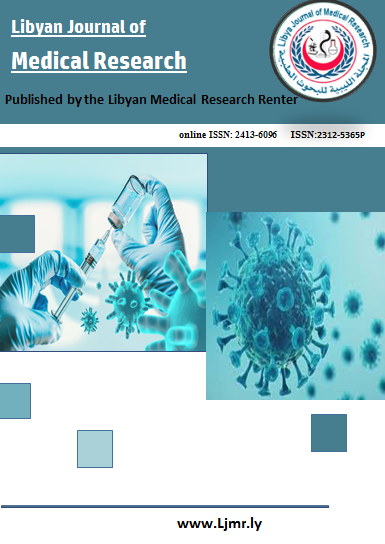Nephrogenic diabetes insipidus: potential treatments and their mechanisms of action.
DOI:
https://doi.org/10.54361/LJME.19.1.13Keywords:
Aquaporins, Nephrogenic diabetes insipidus, AQP2, Statins, Secretin agonistsAbstract
Nephrogenic diabetes insipidus (NDI) is a rare disease caused by the complete or partial resistance of the kidneys to antidiuretic hormone (ADH). NDI associated with excessive urine production and severe thirst. There are two types of NDI; acquired NDI and congenital NDI. Acquired NDI is the most common type among adults, with several factors that can cause acquired NDI, for instance, lithium therapy and electrical disorders. Congenital NDI can occur due to mutations in either the arginine vasopressin receptor 2 (AVPR2) gene or the aquaporin-2 (AQP2) gene. New effective treatments for NDI are required because the disease can be life treating if left untreated. Current animal studies showed that rolipram and metformin are two potential treatments for congenital NDI by upregulation the apical expression of AQP2 channels. Other animal studies illustrated that the combination of different drugs, such as, secretin agonist and fluvastatin could be an effective method to treat XNDI. Furthermore, some agents were found to be able to treat more than one type of NDI, for example, sildenafil citrate could be potently used to treat acquired NDI and XNDI, while statins could be promising treatments for congenital NDI and autosomal NDI. However, further investigation and human trials are needed before it can be decided if these drugs can be clinically used as a treatment for NDI.
Downloads
References
Kalra, S., Zargar, A.J., Jain, S.M., Sethi, B., Chowdhury, S., Singh., A.K., Thomas, N., Unnikrishnan, A.G., Thakkar, P.B., and Malve, H. 2016. Diabetes insipidus: The other diabetes. Indian Journal of Endocrinology and Metabolism. 20(1), pp. 9 – 21.
Bech, P.A., Wetzels, J.F.M., and Nijenhuis, T.2018. Effects of sildenafil, metformin, and simvastatin on ADH-independent urine concentration in healthy volunteers. Physiological Reports. 16(7), pp. 1-7.
Rare diseases. 2016. Nephrogenic Diabetes Insipidus. [Online]. [Accessed 15 November 2024]. Available from: https://rarediseases.org/rare-diseases/nephrogenic-diabetes-insipidus/.
Bockenhauer, D., and Bichet, D.G. 2014. Urinary concentration: different ways to open and close the tap. Pediatric Nephrology. 29(8), pp. 1297 – 1303.
Bonfrate, L., Procino, G., Wang, D.Q.H., Svelto, M., and Portincasa, P. 2015. A novel therapeutic effect of statins on nephrogenic diabetes insipidus. Journal of Cellular and Molecular Medicine. 19(2), pp. 265-282
Milano, S., Carmosino, M., Gerbino, A., Svelto, M., and Procino, G. 2017. Hereditary nephrogenic diabetes insipidus: pathophysiology and possible treatment. an update. International Journal of Molecular Sciences. 18(11), pp. 2385-2441.
Wesche, D., Deen, P.M.T., and Knoers., N.V.A.M. 2012. Congenital nephrogenic diabetes insipidus: the current state of affairs. Pediatr Nephrol.27(12), pp. 2183 – 2204.
Moeller, H.B., Rittig, S., and Fenton, R.A. 2013. Nephrogenic Diabetes Insipidus: Essential Insights into the Molecular Background and Potential Therapies for Treatment. Endocrine Reviews. 34(2):278–301.
Dollerup, P., Thomsen, T.M., Nejsum, L.N., Færch, M., Österbrand, M., Gregersen, N., Rittig, S., Christensen, J.H., and Corydon, T.J. 2015. Partial nephrogenic diabetes insipidus caused by a novel AQP2 variation impairing trafficking of the aquaporin-2 water channel. BMC nephrology. 16(1), pp.217 – 228.
Fricka, A., Erikssona, U.K., de Mattiab, F., Öberga, F., Hedfalka, K., Neutzea, R., de Gripc, W., Deenb, P.M.T., and Törnroth-Horsefielda, S. 2014. X-ray structure of human aquaporin 2 and its implications for nephrogenic diabetes insipidus and trafficking. Proceedings of the National Academy of Sciences. 111(17), pp. 6305 – 6310.
Li, W., Zhang, Y., Bouley, R., Chen, Y., Matsuzaki, T., Nunes, P., Hasler, U., Brown, D., and Lu, H.A.J. 2011. Simvastatin enhances aquaporin-2 surface expression and urinary concentration in vasopressin-deficient Brattleboro rats through modulation of Rho GTPase. American Journal of Physiology–Renal Physiology. 301(2), pp. F309 - F318.
Soh, J.F., Torres-Platas, S.G., Beaulieu, S., Mantere, O., Platt, R., Mucsi, I., Saury, S Renaud, S., Levinson, A., Andreazza, A.C., Mulsant., B.H., Müller, D., Schaffer, A., Dols., A., Cervantes, P., Low, N.C., Herrmann, N., Christensen, B.M., Trepiccione, F., Rajji, T., and Soham Rej, S. 2018. Atorvastatin in the treatment of Lithium-induced nephrogenic diabetes insipidus: the protocol of a randomized controlled trial. BMC Psychiatry. 8, pp. 2-7.
Procino, G., Maiolo, D., Barbieri, C., Milano, S., Squatrito, S., Svelto, M., and Gullo, D. 2014. Fluvastatin Increases AQP2 Urine Excretion in a Dyslipidemic Patient with Nephrogenic Diabetes Insipidus: An In Vivo and In Vitro Study. Journal of Diabetes and Metabolism. 5(7), pp.408- 414.
Procino, G., Milano, S., Carmosino, M., Barbieri, C., Nicoletti, M.C., Li, J. H., Wess, J., and Svelto, M. 2014. Combination of secretin and fluvastatin ameliorates the polyuria associated with x-linked nephrogenic diabetes insipidus in mice. Kidney International. 86(1), pp. 127–138.
Klein, J.D., Wang, Y., Blount, M.A., Molina, P.A., LaRocque, L.M., Ruiz, J.A., and Sands, J.M. 2016. Metformin, an AMPK activator, stimulates the phosphorylation of aquaporin 2 and urea transporter A1 in inner medullary collecting ducts. American Journal of Physiology–Renal Physiology. 310(10), pp. F1008 - F1012.
Efe, D., Klein, J.D., Lauren M. LaRocque, L.M., Ren, H., and Sands, J.M. 2016. Metformin improves urine concentration in rodents with nephrogenic diabetes insipidus. JCI insight. 1(11), pp. 1-11.
Sohara, E., Rai, T., Yang, S., Uchida, K., Nitta, K., Horita, S., Ohno, M., Harada, A., Sasaki, S., and Uchida, S. 2006. Pathogenesis and treatment of autosomal-dominant nephrogenic diabetes insipidus caused by an aquaporin 2 mutation. Proceedings of the National Academy of Sciences. 103(38), pp. 14217 – 14222.
Sanches, T.R., Volpini, R.A., Shimizu, M.H.M., de Bragança, A.C., Oshiro-Monreal, E., Seguro, A.C., and Andrade, L. 2012. Sildenafil reduces polyuria in rats with lithium-induced NDI. American Journal of Physiology–Renal Physiology. 302(1), pp. F216–F225.
Assadi, F., and Sharbaf, F.G. 2015. Sildenafil for the Treatment of Congenital Nephrogenic Diabetes Insipidus. American Journal of Nephrology. 42(1), pp. 65 – 69.
Low, N.C., Herrmann, N., Christensen, B.M., Trepiccione, F., Rajji, T., and Rej, S. 2018. Atorvastatin in the treatment of Lithium-induced nephrogenic diabetes insipidus: the protocol of a randomized controlled trial. BMC Psychiatry. 18(1), pp. 1-7.
Downloads
Published
Issue
Section
License
Copyright (c) 2025 Siraj W A Alabeedi1, Mohamed K A Elkawafi (Author)

This work is licensed under a Creative Commons Attribution-NonCommercial-NoDerivatives 4.0 International License.
Open Access Policy
Libyan journal of medical Research (LJMR).is an open journal, therefore there are no fees required for downloading any publication from the journal website by authors, readers, and institution.
The journal applies the license of CC BY (a Creative Commons Attribution 4.0 International license). This license allows authors to keep ownership f the copyright of their papers. But this license permits any user to download , print out, extract, reuse, archive, and distribute the article, so long as appropriate credit is given to the authors and the source of the work.
The license ensures that the article will be available as widely as possible and that the article can be included in any scientific archive.
Editorial Policy
The publication of an article in a peer reviewed journal is an essential model for Libyan journal of medical Research (LJMR). It is necessary to agree upon standards of expected ethical behavior for all parties involved in the act of publishing: the author, the journal editorial, the peer reviewer and the publisher.
Any manuscript or substantial parts of it, submitted to the journal must not be under consideration by any other journal. In general, the manuscript should not have already been published in any journal or other citable form, although it may have been deposited on a preprint server. Authors are required to ensure that no material submitted as part of a manuscript infringes existing copyrights, or the rights of a third party.
Authorship Policy
The manuscript authorship should be limited to those who have made a significant contribution and intellectual input to the research submitted to the journal, including design, performance, interpretation of the reported study, and writing the manuscript. All those who have made significant contributions should be listed as co-authors.
Others who have participated in certain substantive aspects of the manuscript but without intellectual input should only be recognized in the acknowledgements section of the manuscript. Also, one of the authors should be selected as the corresponding author to communicate with the journal and approve the final version of the manuscript for publication in the LJMR.
Peer-review Policy
- All the manuscripts submitted to LJMR will be subjected to the double-blinded peer-review process;
- The manuscript will be reviewed by two suitable experts in the respective subject area.
- Reports of all the reviewers will be considered while deciding on acceptance/revision or rejection of a manuscript.
- Editor-In-Chief will make the final decision, based on the reviewer’s comments.
- Editor-In-Chief can ask one or more advisory board members for their suggestions upon a manuscript, before making the final decision.
- Associate editor and review editors provide administrative support to maintain the integrity of the peer-review process.
- In case, authors challenge the editor’s negative decision with suitable arguments, the manuscript can be sent to one more reviewer and the final decision will be made based upon his recommendations.














